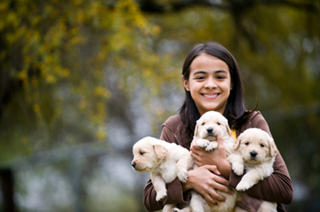No More JumpingMike Romberger, CBCC-KA
Jumping is a natural behavior for dogs. When dogs greet each other, they meet face to face and sniff each other’s muzzles. In most cases, when a dog jumps on you it is simply to greet you face to face. The bigger problem we encounter with jumping is that we have encouraged jumping in our dogs, usually without realizing it. We start teaching jumping very early in our dog’s life. As a puppy, we encourage jumping. It is fun when the puppy jumps on us and licks our faces. Unfortunately, as the puppy gets older and bigger, the jumping is no longer cute and can become frustrating. The most common ways to stop jumping is to push the dog away or to yell at the dog. While these techniques may work in rare instances, they actually reinforce the jumping. Dogs interpret pushing as an attempt to play. People tend to get more animated and excited when yelling. This, too, signals to the dog that play is to be initiated. The first step in reducing jumping is to remove any reinforcement or attention. When your dog jumps on you, turn 180º away from the dog and ignore the dog. When all four paws are on the floor, immediately say “Good” and reward the dog with a pet or a treat. If your dog knows the Sit cue, you can incorporate it into the training. When your dog jumps say, “Sit” and reward your dog for sitting. Sit is a great tool because it is incompatible with jumping. In other words, a sitting dog cannot jump on you. From a behavior perspective, it is always better to teach a behavior you want (Sit) rather than trying to stop a behavior you want to stop (jumping). In the end, you will teach your dog that good things happen when sitting, which will have effects beyond jumping. Totally ignoring your dog is a great way to reduce the jumping, but it is just the start. If you are only trying to train your dog when he is jumping, you will have limited results. It is always better to reinforce the behavior you want at random times. If your dog walks past you without jumping, it is a perfect opportunity to praise or treat your dog for having four paws are on the ground. The more you reward the dog for the correct behavior, the easier it is for the dog to recognize the lack of reward for jumping. As you encourage the behavior you want, the less frequently the dog will jump. If you want to remove jumping from your dog’s repertoire of behaviors, you must enforce a Zero Tolerance policy. This includes all family members, friends, and anyone that will encounter your dog. It is up to you to educate everyone on how they should respond to your dog if he decides to jump. If you allow your dog to jump on just one person, it will set back your training routine since it will confuse your dog. Dogs are not good at trying to figure out whom they can jump on and those they cannot. For your part, the best course of action is to teach your dog Sit and Stay when greeting people. This will reinforce your dog’s notion that good things happen when sitting. Unfortunately, we all know someone that has no problem ignoring your Zero Tolerance policy. In fact, they tend to encourage jumping and justify their actions by saying, “It’s OK, dogs love me.” This is always a tough situation. You will need to decide how to handle it. For me, nothing beats a good Sit and Stay to ensure such a situation will not occur. When developing a plan to help your dog stop jumping, ask yourself, “What am I doing to encourage jumping.” It could be as simple as your dog is excited to see you. In this case, bring yourself down to the dog’s level so jumping is not necessary. Remember, jumping is a side effect of their devotion to you. ©2013 Who's Your Doggie. Mike Romberger is the owner of Who’s Your Doggie in Harrisburg, PA. Mike is a certified canine behavior consultant that specializes in rescue dogs. He has spent most of his career preparing dogs for adoption by modifying behavior through positive reinforcement methods. Mike can be found at www.WhosDoggie.com. |



